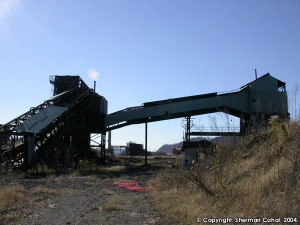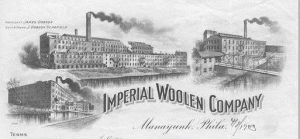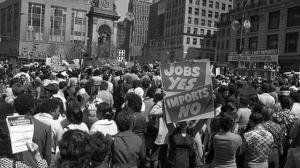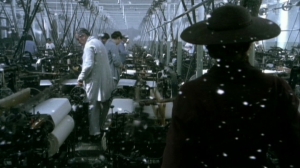While you are out taking a drive, have you taken notice of old abandoned buildings that were once part of the Industrial Revolution in the United States? Do you ever stop and wonder what was behind this building’s history? What did the workers do there? What were their lives like back then? I have noticed these old pieces of architecture in our landscape and have felt that they were important pieces of history that I should know about. Around 2007, I wanted to take photographs of some of these past haunts that you see while driving down Old US 52 in Ohio. By the time my interest peaked about doing this project, I noticed on my drives that these buildings were being demolished. I felt sad about that because I felt a piece of our history was being erased.
One of the buildings I have been referring to was the New Boston Coke Corp Plant in New Boston, Ohio, near Portsmouth. This plant operated between 1917 and 2002. The New Boston Coke Plant operated 70 ovens and had a production capacity of approximately 1,100 tons of coke per day. It was known to be a pretty important economic force of work in the U.S. during WWII with it being the largest production center of 500-lb bombs that helped the United States win the war against Germany and Japan. It was considered the most modern steel mill in the country in 1948 employing 3,800. It moved up to 4,800 in the 1950’s and then came to a gradual shutdown of the entire plant by 2002. This shutdown was due to increased foreign competition and also the high rate of air pollution and of soil and water. Cancer rates in New Boston climbed to be some of the highest in the United States.
Another historical Southern Ohio business was the Carlyle Labold Tile and Brick Company. In 1887, this company’s roots had its beginnings in Portsmouth, OH and was called the Petersburg Brick Company, then the Deegan Brick Company and then the Forestdale Fire Brick Company. In 1923, Mesars, Carlyle, and Labold began experimenting with clay from Lawrence County, specifically Petersburg (later Coal Grove) and Sheridan and found the clay to be of good quality. Carlyle Labold constructed a new, modern factory which produced its first brick in 1925. An elevated span from the factory to the clay mines over Pike Street and the Norfolk & Western Railroad (N&W) was opened in 1929. By the fall of 1928, their brick operation was so successful that a tile plant adjoining the brick plant was constructed and they changed their name to Carlyle Labold Tile and Brick to reflect their new product line.
The clay was shaped into tile instead of brick. The annual capacity of the plant was 12 million building bricks and as many tiles. They made 10 different shapes of faced building brick and 10 different shapes of tile. The plant was electrically operated, except for the coal used in the kilns of the brick division and the gas kilns in the tile division. In 1935, the plant was sold to Mosaic Tile Company and operated under that name until 1978 when all operations ceased. McGuiness Incorporated purchased the 30.85 acre property in 2006. The former brick and tile plant was planned to be home to an intermodal rail, barge, and truck freight center which never got completed. The buildings were demolished and the demolition completed by January 2007. The Ohio EPA found a high level of poly-nuclear aromatic hydrocarbons (PAH’s) in the soil that exceeded the applicable standards so the village of Coal Grove became part of an Ohio EPA Voluntary Action Program(VAP) to help with site clean-up and remediation of the property.
So, here we have two booming and thriving businesses at one time in the Southern Ohio area that are gone among many others out there. Not even their buildings still stand. Old industry had unhealthy work conditions because of all of the pollution and endless work hours of working in highly dangerous conditions.
New industry involves the digital age. The ‘new economy’ is believed to have started in the late 1990’s, as high-tech tools, such as the internet, and increasingly powerful computers, began penetrating the consumer and business marketplace. Companies in the new industry are heavily involved in the internet and biotech industries. Manufacturing is going digital. The old way of making things involved taking lots of parts and screwing them or welding them together. Now a product can be designed on a computer and “printed” on a 3D printer, which creates a solid object by building up successive layers of material. The digital design can be tweaked with a few mouseclicks. The 3D printer can run unattended, and can make many things which are too complex for a traditional factory, to handle. An engineer working in the middle of a desert who finds he lacks a certain tool no longer has to have it delivered from the nearest city. He can download the design and print it.
New materials are lighter, stronger and more durable than the old ones. Carbon Fibre is replacing steel and aluminum in products ranging from aeroplanes to mountain bikes. Nanotechnology is giving products enhanced features such as a bandaid that helps heal cuts or crockery that is easier to clean. Our society has moved towards having products made more swiftly and conveniently. The manufacturing jobs of the future will require more skills. Many dull, repetitive tasks will become obsolete. The factory of the past was based on cranking out zillions of identical products: Ford famously said that car-buyers could have any color they liked, as long as it was black. The factory of the future will focus on mass customization- and may look more like those weavers’ cottages than Ford’s assembly line.
What are your thoughts about manufacturing becoming more digital? I think it is better in the way of working conditions being less harsh on workers out there and that health conditions have improved in the workplace. Also, I am for technology improving and becoming better for mankind. If the new industry helps promote less pollution and improves society’s health than I am all for things becoming more convenient as long as our society doesn’t become too fast-paced about everything. I am not wanting to see workers replaced completely by robotics. I think a good mix is workers and robotics mixed to achieve a great result for humanity.
A great movie I would recommend for you to view about, old industry, the textile Industrial Revolution in England is called North and South, based on Elizabeth Gaskell’s novel. Her novel was about how different lifestyles existed in the North of England versus the South of England. Milton England was a picture of how life was in Manchester England at the time


















Our Father worked in the clothing industry all his life and the cloth dust had an effect on his health. Hopefully the industry is totally aware of this problem and the maintenance is better. This dust can lead to what is called an ecological cancer.
LikeLike
Cheryl, so sorry to hear that the cloth dust had an effect on your father’s health. Terribly sorry to hear that. That is a scary thing that we have ecological cancers or cancers of any kind out there! Thank you so much for taking your time to read my article and comment! 🙂
LikeLike
I really enjoyed your blog OI vs NI. It looked like you did your research really well and had a lot of interesting tidbits and facts about those long lost factories up the old 52. My thoughts on abandoned buildings still stands as either put something in it or tear it down because its basically wasting space and sometimes even an eyesore. My thoughts on technology are that it is good and bad. Good meaning lots of more convenient and easier ways to get things done, but bad in the aspect that people are losing their ability to spend quality time with the earth and people and have their noses stuck in a phone at events, concerts, seminars, or just being out with friends and that is a shame and I am guilty as charged as well, but not entirely as bad as the entire. Also, malfunctionality is scary to me in the advent of robotics taking over and could end up being synonymous to what happens in the terminator films or a lot of the futuristic films that come out nowadays (especially cloning is used a lot).
good read sis. keep on with it.
LikeLike
Thanks so much Brian for reading my article and making comments about it! 🙂 I agree with you that wasted space is not a good thing at all and these abandoned businesses can be eyesores and can become ecologically unsafe for the environment and community. I think technology is great in some ways with advancement of health and helping people be more social but also bad if people can’t tear themselves away from the devices. Everyone needs to have eye contact and be acknowledged and have conversation with other people. God created us to relate with each other and not hide ourselves in a screen 24/7. Robotics completely infiltrated in every aspect of our society like the Terminator films would be a scary thing indeed!
LikeLike
Dear Jennifer, very good article in relation about my last post about third industrial revolution and the digital age 🙂 Concerning the fourth industrial revolution and what could be the artificial awareness, I would recommand to see the film “Her”; the film itself is very interesting about artificial awareness without seeing it as a “pandora box” : http://en.wikipedia.org/wiki/Her_(film)
LikeLike